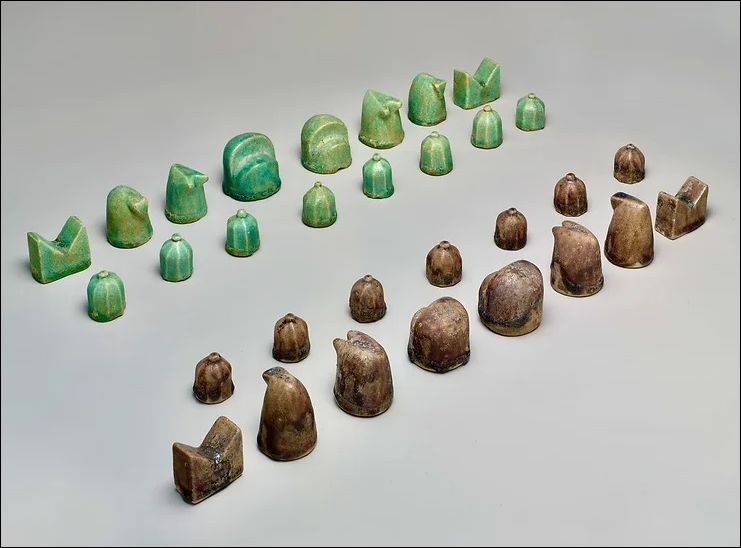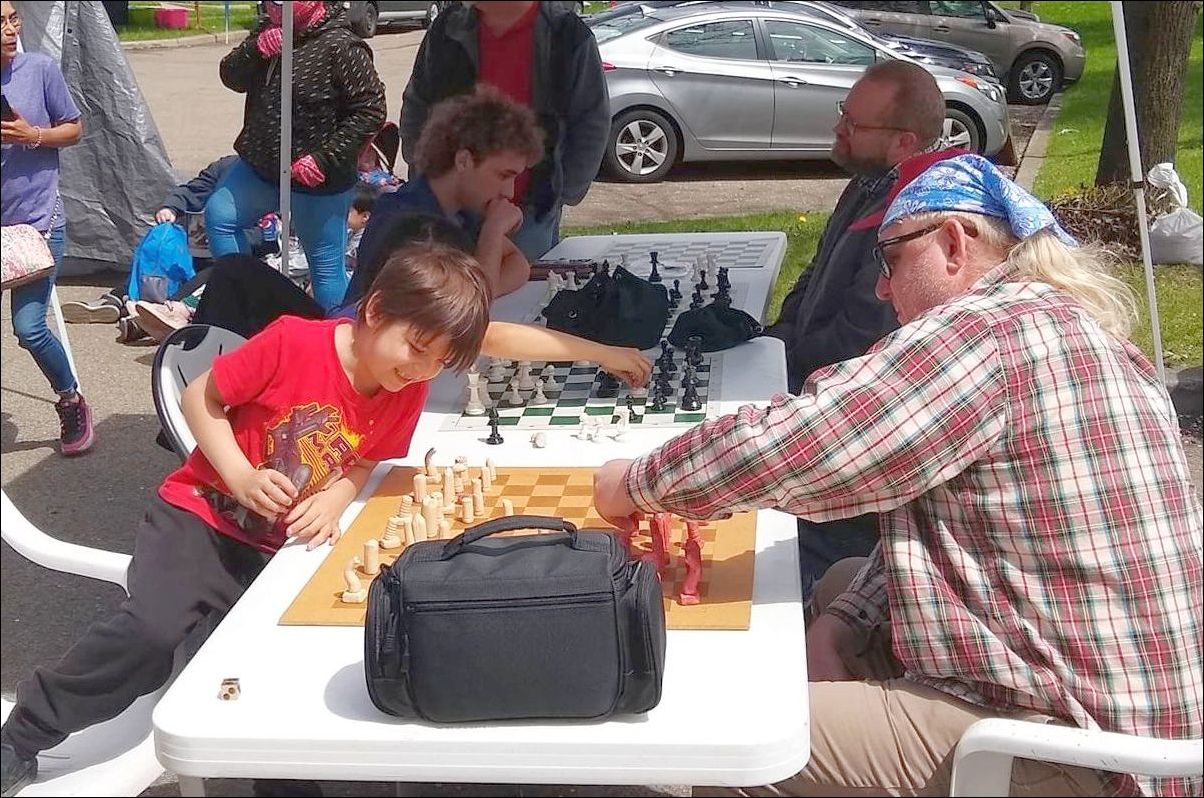.jpeg)

.jpeg)
As a follow-up to our three-part series on ‘A new wave of chess stars’ (see part 1, part 2 and part 3), which led us to appreciate Central Asia’s long-standing chess tradition and Timur the Great, the chess loving emperor, it was interesting to discover that, thanks to dedicated individuals who follow their own heart’s pursuits, ancient chess variants are still alive today. An overwhelming number of enthusiasts and associations throughout the world cultivate old chess variants and other board games.
In Jamestown, NY, there is a club called ‘Tamerlane Chess Club’. It is a normal chess club — meaning it is USCF affiliated and can hold rated classical chess tournaments — but a big part of the club’s activities are connected to the ancient variant. Its founder, Greg Myers, painstakingly researched, studied and reconstructed Tamerlane Chess, created chess sets, instructed players in the game and organized thematic friendly tournaments! He has initiated the process of obtaining a certification for running professional tournaments.

Greg Myers and the logo of his club | Photo: Tamerlane Chess Club
The source that served to revive Tamerlane Chess is a 15th century manuscript housed in a container known as ‘Box 87’ at the Royal Asiatic Society in London. Greg’s personal initiative and research brought him to this dust-covered document called ‘Manuscript 211’, which held the Tamerlane Chess’ secrets.
Greg, the modern-day recreator of the game, noted:
The Tamerlane Chess diagram from Manuscript 211, written in the 15th Century, is the world’s only source for the rules of Tamerlane Chess. Without this document, I would have spent the last couple of years organizing my pine cone collection on Thursday evenings.
Instead, Greg has put his heart and efforts into bringing this ancient game to the attention of aficionados in modern times. An 18th century translation by Nathaniel Bland, an English orientalist, helped him to wade through the content of this miraculously preserved manuscript written in the Naskh script of Islamic calligraphy.

The 15th century manuscript with a diagram and the rules of Tamerlane Chess
How the manuscript ended up at the Royal Asiatic Society in London as well as Greg’s adventure searching for it are interesting stories in themselves. Both included a passionate person who overcame all obstacles to fulfil his curiosity and heart’s desire.
You can read more about Greg’s discovery in a PDF document entitled ‘On The Provenance Of Manuscript 211’. It contains a historical chronology of the creation of the manuscript, its description by various scholars and its amazing journey until it reached the Royal Asiatic Society’s Library.
A brief excerpt from the document refers to Ali the Chess Player, the possible author of the Manuscript:
The author of the manuscript is officially listed as "unknown" although at least one chess historian believes it was probably written by a man named Ali A-Shatranji, translating to Ali The Chess Player. Ali was a celebrated chess player at Timur's court and would sometimes travel for years and hundreds of miles through the desert with Timur on his various campaigns to destroy and overthrow new regions of the world.
[...] Ali the Chess Player, a common presence on these campaigns, was said to have a very arrogant manner, often boasting lavishly about his feats in the game of chess, claiming to have played fifty men at once, while blindfolded, and taking credit for the invention of many forms of the game. The writing style of the tattered manuscript gifted to the Royal Asiatic Society is similarly braggadocious, often referring to the author's own achievements, at one point stating the following: “And I have invented several positions in the Great Chess, and several tactics, which were unknown to former professors; and many of those which were left imperfect by the older players, I defended and rectified, and improved and completed what had already been discovered in Chess”.
It is this self grandiosity combined with his apparent familiarity with the courts of Tamerlane that has led to the conclusion by the late chess historian Duncan Forbes that the author of the manuscript is indeed Ali the Chess Player.
Once Greg put his mind to reviving Tamerlane Chess, the first hurdle to overcome was providing chess sets. There are no mass-produced sets of the kind, so Greg took it up to himself to make a few fairly simple ones with plywood boards and stylized pieces made of polymer clay baked in the oven.

One of the first trials: a large Tamerlane Chess board with its corresponding pieces created by Greg | Photo: Wikimedia Commons

Home-made Tamerlane Chess sets created by Greg and club members
Some of the pieces Greg modelled after a 12th century chess set from Iran.

Chess set (12th century, Iran) at the Metropolitan Museum, New York | Photo: Bayt Al Fann
During the chess club’s meetings, Greg instructs interested students in the secrets of a game played many centuries ago by a fearful emperor, Timur the Great, while on neighbouring tables, other club members are engaged in classical chess games.

New adherents eagerly follow Greg’s instructions in Tamerlane Chess
Other club members assist in the popularization of the ancient variant.

Kirk Allen, a regular club member with his own, improvised Tamerlane Chess set

Open air modern chess being played next to the ancient chess variant: a kid is being instructed in Tamerlane Chess by Kirk Allen
The club's modest library has a collection of 70 chess books, 40 chess sets, 20 ancient chess variants sets, magazines and more!

Just a small corner of the Tamerlane Chess Club Library
One outlet where Greg presented Tamerlane Chess to larger audiences is the Erie Days of Games, a board gaming convention in Erie, Pennsylvania.

The Erie Days of Games is a joyful community gathering that celebrates board games

Tamerlane Chess at the Erie Days of Games
The basics about the game are the following: it is played on a board of 10 rows and 11 files (110 squares) plus two additional squares that protrude on the sides of rows 2 and 9, called ‘citadels’, for a total of 112 squares. This is the composition of the game now known as ‘Grand Tamerlane Chess’.
There was a smaller, simpler version in Timur’s time, but we will focus on the ‘grand’, more complex version of the game, which was Timur’s preferred variant because of its complexity, intellectual challenge and beauty. Originally the board was unchequered, which made the game even more difficult.
There are 28 pieces per player, or 56 in total. The pieces are:
In Tamerlane chess, each piece has a corresponding pawn. Each pawn represents the piece in front of which it stands, and when it reaches the other side of the board it promotes to the piece that it represents. There is the pawn of Shah, pawn of Ferz, pawn of Wazir, and so on.

Unchequered board with red and black game pieces; detail from a folio from Shahnama (Book of Kings) at the Metropolitan Museum of Art, New York | Photo: St Thomas Guild / Medieval Chessboards
Greg has created a YouTube channel for the Tamerlane Chess Club. In a few videos, he explains meticulously the intricacies of the ancient game.
An introductory video explains ‘Piece Values, Tactics, and Clarifications’. In three separate videos he covers the rules of the game.
Another video, entitled ‘Chess Notation’, deals with the Tamerlane chess notation, which is Greg’s own creation based on the algebraic notation in regular chess. Having sorted the notation, Greg turned into a Tamerlane Chess ‘problemist’ and composed several studies. He challenges students to solve them and awards the successful ones with a free membership to his club.

One of the simplest problems: mate in two, White to move (Answer: picket to h6)
There is also a video called ‘Tamerlane Chess: Answering Questions’, which has attracted many curious enthusiasts.
Will you get to master Tamerlane Chess after watching all these videos? Probably not. It takes much patience, stamina and dedication to come anywhere near to understanding this complex game and its rules. One-to-one lessons would be beneficial. To me, it is overwhelmingly difficult, but then someone with super intelligence may crack the game quickly enough.
From these considerations, another question arises: if classical chess is already complex enough, why bother with this insanely complex variant? The authors of Chess Variants, a portal that contains all sorts of chess and board game variants, give a justification:
Chess is a game that requires abstract thinking and forethought. This is a general quality of abstract, strategy board games. Playing chess variants keeps you on your toes more. You can’t fall back on knowing opening moves better than your opponent does. To do well, you have to be aware of everything that is going on and have a good command of chess strategy and tactics. This makes playing chess variants a good way to develop the intellectual capacities that help you play chess well.
Winning at a chess variant is more a feat of intellect than winning at chess is. It doesn’t take reasoning abilities to memorize opening moves in chess. Thanks to the detailed analysis of opening moves in chess, which many books have been written on, someone with a good memory could easily defeat someone whose main strength in chess is a keen intellect. Like Sherlock Holmes, I am more interested in intellectual challenge than I am in filling my mind with trivia. Knowledge of opening moves has no use outside of chess, and the prospect of studying the literature on it seems too boring to me. I would rather venture into uncharted territory, as I do with chess variants, than play a game where memorization gives someone a huge advantage.
Obviously, each has their own right to differ in opinion. Here we are looking at just one of many, many variants, ancient and new, that exist today and that have an astounding number of followers. Also, Greg Myers is just one of many worthy re-inventors of variants, authors of books and researchers of ancient chess and other board games.
An additional curiosity that occupies Greg’s mind is astronomy. He is a keen amateur astronomy photographer. For the moment, he limits his experiments to photographing the Moon in a simple manner: with a cell phone camera attached to a Dobsonian telescope.

Greg’s photos of the Moon
Our chat on astronomy was triggered after I saw an intriguing photo of a black hole on his Facebook pages. Greg explained:
It might be the first picture of the supermassive black hole at the center of our galaxy that you saw. It was taken by a collaboration known as the Event Horizon Telescope, which is actually a combination of data from many telescopes around the globe.
Until recently a photo of a black hole was not possible, because by definition black holes emit no light. But with new technology, we are able to view the material that is swirling around the black hole, in danger of falling in, and the black hole itself shows up as a round shadow at the center.

The first photo of a black hole using data collected with the Event Horizon Telescope | Photo: science.org
He is quick to add that another person would have been delighted by this discovery: Ulugh Beg (1394 – 1449), the famous astronomer at the court of Timur the Great.

Ulugh Beg's portrait at the Ulugh Beg Observatory in Samarkand, Uzbekistan
| Advertising |